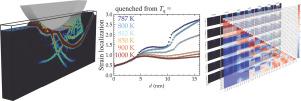Plasticity of metallic glasses dictated by their state at the fragile-to-strong transition temperature
IF 8.3
1区 材料科学
Q1 MATERIALS SCIENCE, MULTIDISCIPLINARY
引用次数: 0
Abstract
The effect of cooling on the plasticity of glasses in general, and bulk metallic glasses (BMGs) in particular, is usually studied with continuously varying cooling rates; slower cooling rates lead to stiffer, harder, and more brittle glasses than higher cooling rates. These protocols obscure any potential discontinuity that a glass might experience, depending on whether its microstructure resembles that of a fragile or a strong glass-forming liquid. Here, we use large-scale molecular dynamics to simulate the nanoindentation behavior of model BMGs (Zr0.6Cu0.3Al0.1) obtained by rapidly quenching equilibrium melts from temperatures above and below the fragile-to-strong transition temperature , leading to fragile and strong glasses, respectively. While the contact modulus deduced from the indentation simulation evolves smoothly with the temperature from which the equilibrium melt is quenched, the plastic response changes quasi-discontinuously as passes through . In particular, strong glasses develop highly asymmetric flow profiles with mature shear bands, unlike fragile glasses. Differences are most evident in the von Mises strain localization parameter, which, after shear-band formation, takes similar values for all fragile samples and distinct values for strong samples. Moreover, seemingly erratic flow profiles for our indentation geometry produced surprisingly reproducible and, thus, deterministic features. It remains to be determined to what extent other classes of glass formers follow our observation that plastic behavior is significantly influenced by whether the melt is fragile or strong when it falls out of equilibrium during cooling.


求助全文
约1分钟内获得全文
求助全文
来源期刊

Acta Materialia
工程技术-材料科学:综合
CiteScore
16.10
自引率
8.50%
发文量
801
审稿时长
53 days
期刊介绍:
Acta Materialia serves as a platform for publishing full-length, original papers and commissioned overviews that contribute to a profound understanding of the correlation between the processing, structure, and properties of inorganic materials. The journal seeks papers with high impact potential or those that significantly propel the field forward. The scope includes the atomic and molecular arrangements, chemical and electronic structures, and microstructure of materials, focusing on their mechanical or functional behavior across all length scales, including nanostructures.
 求助内容:
求助内容: 应助结果提醒方式:
应助结果提醒方式:


